In Missouri’s woods, a native, thorny, locust tree displays clusters of fragrant white flowers.
The black locust (Robinia pseudoacacia) grows in dry or rocky upland woods, along streams, and in pastures, and thickets.
Black locust trees bloom in May and June, emitting a fragrant aroma and signaling seasonal changes. Often considered a nuisance species, black locusts play an important role in colonizing disturbed areas, and providing food and habitat for wildlife.
A pioneer tree species, black locust easily invades disturbed sites, and is often considered a nuisance species.
Black locusts are prolific seed producers, but an impermeable seed coat prevents most from germinating. Instead, most natural reproduction occurs as sprouts and suckers arise from stumps and an extensive root system beneath existing trees.
Widely planted for wind breaks, soil erosion control and as an ornamental, these trees play an important role in colonizing disturbed sited.
Black locust wood ranks seventh-hardest of any tree in North America, and is used for fence posts and firewood.
Aromatic blossoms in May and June provide a good nectar source for bees, while deer browse the leaves and twigs and squirrels and quail eat the seeds.
Look for these tough trees in Missouri’s rugged landscape, and enjoy their fragrant flowers on your next outdoor adventure.
Learn more about black locusts and other flowering spring trees, with the Missouri Department of Conservation’s online field guide.

BLACK LOCUST – Black locust trees bloom in May and June, emitting a fragrant aroma and signaling seasonal changes. Often considered a nuisance species, black locusts play an important role in colonizing disturbed areas, and providing food and habitat for wildlife.



Facebook Comments